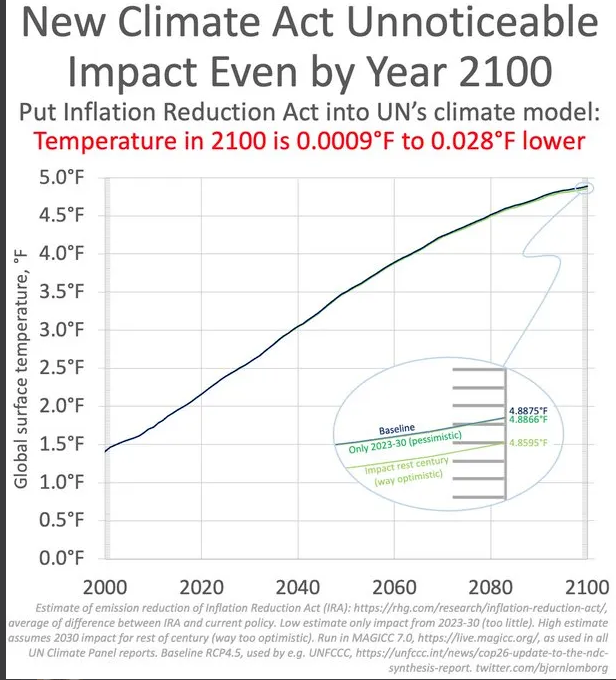Joe:
Australia has lost between 5 and 10 thousand homes to climate disasters since 2019.
I mentioned in my prior posting that I misread portions of your comment on Gates, but specific to your point about homes lost due to climate disasters:
Globally, there are far fewer lives lost and far less damage to property/structures now compared to years past due to advances in structural planning, preparedness and other factors (which include the use of historical forms of energy — gas, carbon, oil, etc — to facilitate).
But beyond that, as I’ve been repeating for some time: changes to climate does NOT by default = changes are due primarily to human-based activities/emissions, especially when compared to climate/weather patterns going back thousands of years, well before modern human industry (and also the notions that human-generated CO2 levels are primary drivers of increased CO2; and the extent higher CO2 is a cause for imminent concern as currently broadcast by those subscribing to these theories, without consideration to myriad other factors that influence climate fluctuations over time).
To be clear, none of the above suggests no action should be taken to address climate changes.
But we are being told the reasons for climate changes are due principally to human activities as primary factor, and importantly, that commoners everywhere will need to submit to imposed broad-scale austerity measures and restrictions on human agency/rights as a ‘critical’ need to ‘combat’ these changes.
It’s alarming that so many are perfectly willing (and clamoring) to adopt these measures, seemingly without a hint of scrutiny or discernment. Which is precisely what we just observed from 2020-2023 for another ‘crisis’ we very recently endured. The parallels are clear and myriad, regardless of any attempts to silence such comparisons.
While the below link includes indications that human-based activities contribute to climate change (as expected — the aim of this piece is not to challenge the current narratives), NOTE the non-human factors cited in the below excerpt, specifically with respect to Australia and causes for the recent extreme weather conditions:
Climate influences
A major global-scale cause of the extreme weather conditions in 2019 was the Indian Ocean Dipole (IOD), which last year moved into its strongest positive phase since 1997. The IOD is an oscillation that occurs in the sea-surface temperature between the western and eastern tropical Indian Ocean, analogous to the El Niño–Southern Oscillation in the Pacific Ocean. The relatively cool sea-surface temperatures near Australia during a positive IOD typically are linked to southeast Australia’s reduced spring rainfall. Last year’s IOD persisted into the beginning of summer, before being dissipated by a delayed monsoon.
Most often, hot and dry conditions occur when a positive IOD coincides with an El Niño; this year’s extremes occurred in the absence of one. “The fact we’ve had a really serious drought with only one of those factors is quite exceptional,” says Mark Howden, director of the Climate Change Institute at the Australian National University (ANU).
Positive IODs don’t occur that often. From 1960, when records began, there were 10 such events through 2016, according to Australia’s Bureau of Meteorology. Scientists disagree on whether they will increase in number and strength as the climate continues to warm. “There are papers suggesting that the positive IOD will become stronger and more frequent, leading to drier conditions in winter and spring,” says Julie Arblaster, an associate professor of Earth atmosphere and environment at Monash University. Some analyses indicate that a doubling of strongly positive IODs will occur with a global rise of 1.5°, says Howden.
A rare event
One highly unusual occurrence, a breakdown of the Antarctic polar vortex due to sudden stratospheric warming, worsened fire conditions in Australia last year. Such events occur with some frequency in the Northern Hemisphere winter, but they are rare in the Antarctic. Prior to last year, the only other sudden warming was observed in 2002, though weakenings of the vortex have occurred more frequently. By coincidence, a paper Arblaster coauthored in the November 2019 issue of Nature Geoscience describing the effects of those weakenings on Australia’s climate was in review when the actual event was in progress.
Like its counterpart in the Arctic, the southern polar vortex annually weakens in late spring as the atmosphere warms. But last August’s sudden breakdown occurred months ahead of schedule. The effect was to increase the likelihood of spring hot and dry extremes across subtropical eastern Australia, as Arblaster and her colleagues described in their statistical analysis of observations over 40 years. Last year’s collapse of the vortex caused the SAM and the surface westerlies to move northward and prevented the typical moisture-laden southeast trade winds from the Tasman Sea from reaching Australia’s southeastern coast, says Karoly. It’s far too early to draw a connection between climate change and the sudden warming, researchers agree.
Howden points to the extreme low humidity that accompanied the drought and heat waves as an apparent signal of climate change. The relative amount of moisture in the atmosphere has dropped across the midlatitudes that Australia occupies, compared with historical levels.
At the synoptic scale, the current fire season has featured a persistent high-pressure system, centered over the Tasman Sea, that circulated hot, dry air from Australia’s interior desert to the southeastern part of the country, says Howden. When approaching cold fronts increased the pressure gradient in front of the high pressure, winds picked up and added fuel to the fires. Turbulent winds from multiple directions followed passage of the fronts and made the fires difficult to manage. According to Howden, some analyses have suggested that this pattern is likely to grow in frequency as the climate continues to transform.
https://pubs.aip.org/physicstoday/artic ... fires-It-s
I can understand agreement with the currently dominant narratives Re: anthropogenic factors (which are particularly promoted among most if not all first world govts, institutions and organizations that, perhaps not coincidentally, have also been undertaking/pushing increasingly overt and brazen power/control efforts, globally).
The level of desperation, concern and worry will only increase, for a variety of reasons, which puts us all in positions of compromise and vulnerability.







